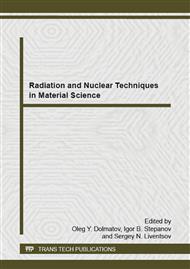[1]
A.M. Granov, L.A. Tyutin, M.S. Tolstanova, The application of positron emission tomography with 18- fluorodeoxyglucose in clinical oncology, Problems in Oncology (Voprosy onkologii, in Russian) 49 (5) (2003) 563-573.
Google Scholar
[2]
A. Aziz, R. Hashmi, Y. Ogawa, Tc-99m – MIBI scintimammography; SPECT versus planar imaging. J. Cancer Bioter. Radiopharm. 14 (6) (1999) 495-500.
DOI: 10.1089/cbr.1999.14.495
Google Scholar
[3]
C.K. Kuhl, MRI of the breast cancer. J. Eur. Radiol. 10 (2000) 46-58.
Google Scholar
[4]
S.J. Kim, Y.T. Bae, J.S. Lee , I.J. Kim, Y.K. Kim, Diagnostic performances of double-phase tc-99m MIBI scintimammography in patients with indeterminate ultrasound findings: visual and quantitative analyses. J. Ann. Nucl. Med. 21 (3) (2007).
DOI: 10.1007/s12149-006-0002-y
Google Scholar
[5]
W. Yu. Ussov, J.E. Riannel, J.M. Michailovic, Quantification of breast cancer blood flow in absolute units using Rutland-Patlak analysis of 99mTc MIBI uptake. Reviews in Nucl. Med. - Countries of Central and east Europe 2(2) (1999) 36-44.
Google Scholar
[6]
S.V. Kanaev, S.N. Novikov, P.V. Krivorot'ko, V.F. Semiglazov, P.I. Kryzhevitskii, Interpretation of breast imaging with 99mTc-MIBI by semiquantitative lesion characterization, Problems in Oncology (Voprosy onkologii – in Russian) 58 (6) (2012).
Google Scholar
[7]
K. Koizumi, K. Toyama, T Araki, Uptake of Tc-99m tetrafosmin, Tc-99m MIBI and 201Tl in tumour cell line, J. Nucl. Med. 37 (1996) 1551-1556.
Google Scholar
[8]
A. Sehweil, J.H. McKillop, R. Milroy, 201Tl scintigraphy in the staging of lung cancer, breast cancer and lymphoma, Nucl. Med. Commun. 1(4) (1990) 263-269.
DOI: 10.1097/00006231-199004000-00002
Google Scholar
[9]
Yu.B. Lishmanov, V.I. Chernov, N.G. Krivonogov, Experimental perfusion scintigraphy using 199Tl chloride, Medical Radiology and Radiation Safety (Meditsinskaya radiologiya i radiatsionnaya bezopasnost', in Russian) 3 (1988) 13-16.
Google Scholar
[10]
Yu.B. Lishmanov, V.I. Chernov, Myocardial scintigraphy in nuclear cardiology, TSU Publishing House, Tomsk, (1997).
Google Scholar
[11]
R.P. Spencer, Tumour-seeking radiopharmaceuticals: nature and mechanisms, J. Nucl. Med. 2 (1994) 649-662.
Google Scholar


